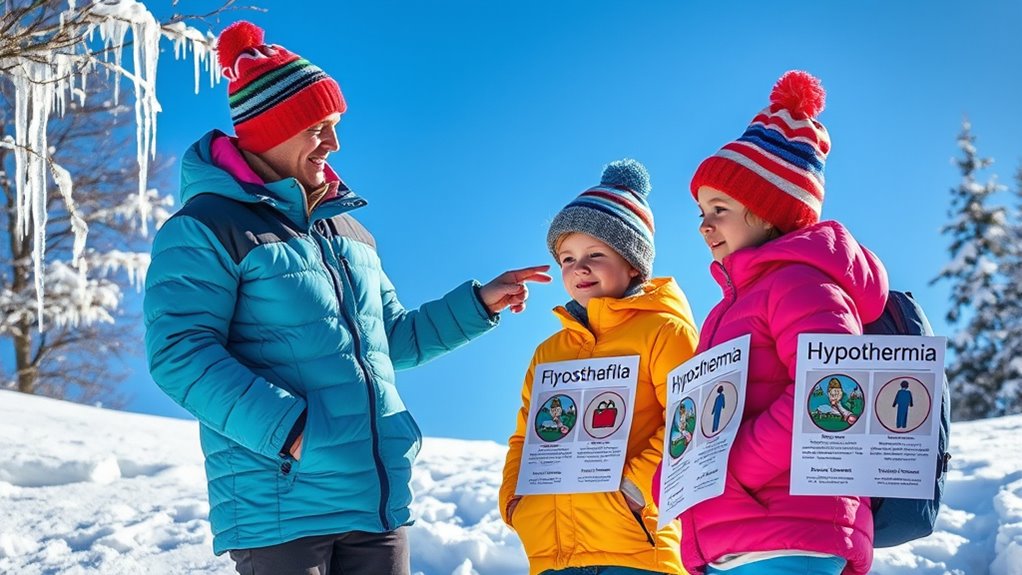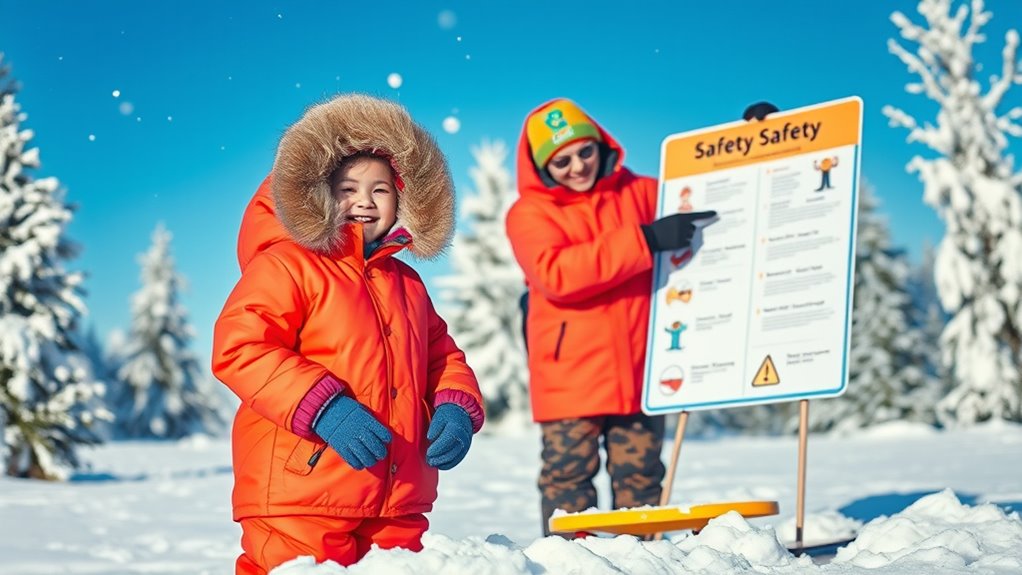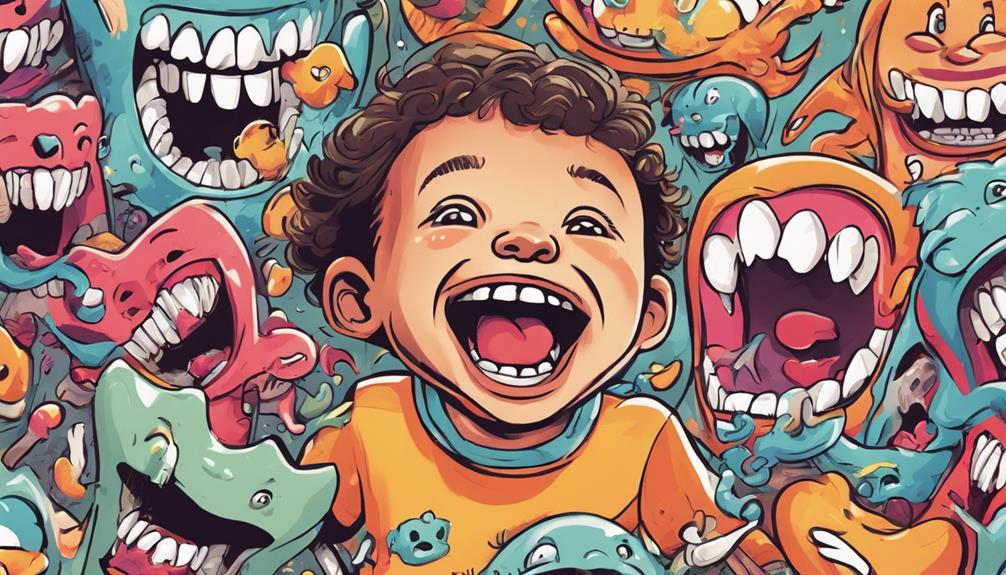To teach kids about snow safety and hypothermia, start by explaining the importance of proper winter clothing, like layered outfits, waterproof gear, hats, gloves, and insulated boots. Remind them to watch for weather hazards, stay dry, and take breaks in warm places. Teach them to recognize signs of cold sickness, such as shivering or confusion, and emphasize prompt action. If you keep exploring, you’ll learn even more ways to keep your kids safe and warm.
Key Takeaways
- Educate children on recognizing signs of cold, such as shivering, numbness, and fatigue, and encourage prompt warming.
- Teach proper winter clothing layers and the importance of staying dry to prevent hypothermia.
- Emphasize safe outdoor play, including wearing helmets and avoiding thin or cracked ice.
- Encourage regular breaks in warm shelters and drinking warm beverages to maintain core temperature.
- Explain the symptoms of hypothermia and instruct kids to seek help if they feel confused, very tired, or uncontrollably shivering.

When children head outside to play in the snow, it is essential to teach them about snow safety and the risks of hypothermia. Kids often get excited to build snowmen, have snowball fights, or go ice skating, but they need to understand how to stay safe and warm. Proper winter clothing is your first line of defense. Make sure they wear layered outfits that include a moisture-wicking base layer, an insulating middle layer, and a waterproof outer layer. Hats, gloves, and scarves are necessary because heat escapes quickly from uncovered skin. When children participate in activities like ice skating, it’s especially important to guarantee their clothing is warm and windproof. Wearing insulated boots will keep their feet dry and warm, which is critical since cold, wet feet can accelerate hypothermia risk.
Dress children in layered, waterproof clothing and warm accessories to stay safe and dry during winter outdoor activities.
Before heading out, teach your kids to check the weather and listen to advisories. Cold, windy days or snowstorms increase the danger of hypothermia, which occurs when the body loses heat faster than it can produce it. Kids may not recognize how cold they’re getting, so remind them to tell you if they start feeling numb, shivery, or overly tired. During outdoor play, encourage frequent breaks in a warm shelter to prevent their core temperature from dropping. If they’re ice skating, make sure they stay aware of the ice conditions and avoid thin or cracked ice, which can be dangerous. Wearing appropriate gear, like helmets and gloves, helps protect them from falls and frostbite.
You should also teach children about the importance of staying dry. Wet clothing makes it easier for their body temperature to plummet, so if they fall into snow or get ice on their clothes while skating, they should change into dry clothes as soon as possible. Carrying extra gloves, hats, and socks is a good idea. Kids often underestimate how cold they are when they’re busy playing, so remind them to come inside periodically for a warm-up. Hydration also plays a role; drinking warm beverages can help maintain their core temperature. Additionally, incorporating essential oils for hypothermia like lavender or eucalyptus in their environment can promote a sense of warmth and comfort, although they should not replace proper clothing and precautions.
Finally, instill in them the importance of recognizing signs of hypothermia, such as confusion, fatigue, or shivering that won’t stop. Teaching children to listen to their bodies and to seek warmth when needed is key to keeping them safe during winter fun. By combining proper clothing, awareness, and cautious play, you help guarantee that your children enjoy the snow safely while minimizing the risk of hypothermia.
Frequently Asked Questions
How Can I Tell if My Child Is Starting to Get Hypothermic?
You can tell your child is starting to get hypothermic if they show shivering symptoms, which indicate their body is trying to generate heat. Watch for pale skin, confusion, or sluggishness, as these are signs of hypothermia. If your child’s shivering stops or they become drowsy, seek immediate medical help. Keep them warm with dry clothing and blankets, and get them to a warm environment as soon as possible.
Are There Specific Clothing Materials Best for Snow Safety?
Think of clothing like a cozy fortress against the cold. Opt for materials with excellent thermal insulation and moisture wicking properties, such as wool or synthetic fabrics like polyester. These keep your child warm and dry, preventing chills and hypothermia. Avoid cotton, which traps moisture and chills the skin. Layering with these materials creates a barrier, ensuring your kid stays safe, warm, and comfortable during snowy adventures.
What Are Early Signs of Frostbite in Children?
You should watch for frostbite symptoms like pale, waxy skin, numbness, or a tingling sensation in your child’s fingers, toes, nose, or ears. Cold exposure warning signs also include shivering, redness, or blotchy skin. If you notice any of these signs, get your child to a warm place quickly, remove wet clothing, and seek medical attention immediately to prevent further damage. Acting fast is vital for frostbite prevention.
How Long Can a Child Safely Stay Outside in Cold Weather?
You should limit your child’s outdoor time in cold weather to prevent cold exposure risks. Generally, children can stay outside for about 15-30 minutes in temperatures below freezing, but this varies based on wind chill and clothing. Watch for signs of discomfort or frostbite, and bring them indoors promptly if they start shivering or their skin becomes pale or numb. Always prioritize warmth and frequent check-ins.
Can Playing in the Snow Cause Long-Term Health Issues?
Playing in the snow can pose some risks, but long-term health issues are uncommon if you take proper precautions. Exposure might impact respiratory health risks or cause minor long-term immune effects if your child frequently plays without proper gear. To minimize these risks, make certain your child wears appropriate clothing, limits time outside, and takes breaks. This way, they can enjoy snow safely while reducing potential health concerns.
Conclusion
Think of snow safety and hypothermia awareness as your toolkit for a winter adventure. By teaching kids these essential lessons, you’re equipping them to navigate the icy landscape safely—like a seasoned explorer armed with a map. When you help them recognize dangers and stay warm, you’re lighting the way through the snowstorm. Remember, a little knowledge is the compass that guides them safely home, making every snowy day a joyful, secure journey.









